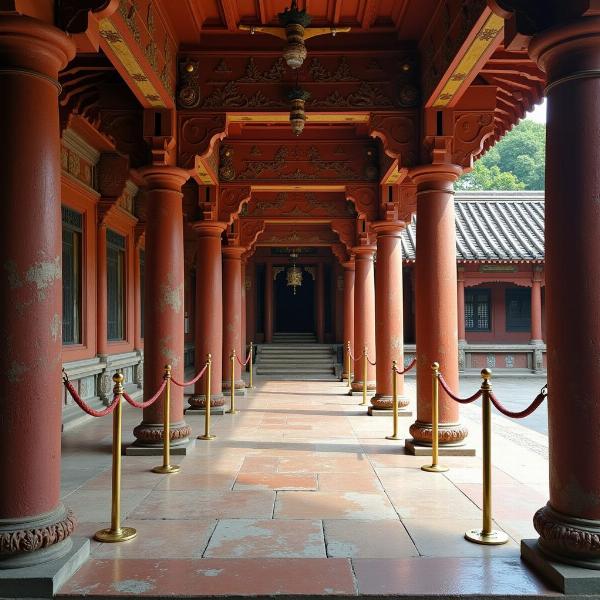Understanding the meaning of “restricted area” in Hindi is crucial for anyone navigating India’s diverse landscape and regulations. Whether you’re a tourist, a business traveler, or a resident, knowing the appropriate terminology and cultural nuances surrounding restricted areas can save you from potential misunderstandings and legal complications. This article will delve into the various Hindi translations, contextual usage, and cultural implications of “restricted area.”
Understanding “Restricted Area” in Different Contexts
The meaning of “restricted area” in Hindi can vary depending on the specific context. Let’s explore some common scenarios:
Military and Defense Zones
In the context of military installations or sensitive defense areas, “restricted area” can be translated as “प्रतिबंधित क्षेत्र” (pratibandhit kshetra). This term clearly indicates that access is prohibited without proper authorization. Another suitable translation is “सुरक्षा क्षेत्र” (suraksha kshetra), which emphasizes the security aspect of the restriction.
Government and Official Buildings
For government buildings or areas with limited public access, the term “प्रवेश निषेध” (pravesh nishedh), meaning “entry prohibited,” is often used. You might also see signs with “अधिकृत व्यक्तियों के लिए ही” (adhikrit vyaktiyon ke liye hi), meaning “for authorized personnel only.”
Private Property and Businesses
When referring to restricted areas within private property or businesses, terms like “निषिद्ध क्षेत्र” (nishiddh kshetra) or “प्रतिबंधित क्षेत्र” (pratibandhit kshetra) can be used. Often, specific signage will indicate the nature of the restriction.
Religious and Cultural Sites
Some religious or cultural sites may have designated restricted areas for specific rituals or for preservation purposes. In such cases, terms like “पवित्र स्थान” (pavitra sthan) meaning “holy place” or “गर्भगृह” (garbhagriha) meaning “sanctum sanctorum,” might be used, indicating limited access.
Navigating Restricted Areas in India
Understanding the signage and local customs related to restricted areas is essential. While official signs often include English translations, being familiar with the Hindi terminology can be beneficial, particularly in more remote areas.
Asking for Clarification
If you’re unsure about whether an area is restricted, it’s always best to ask. Simple phrases like “क्या यह क्षेत्र प्रतिबंधित है?” (kya yah kshetra pratibandhit hai?) – “Is this area restricted?” – can help avoid unintentional trespassing.
Respecting Local Customs
Be mindful of local customs and traditions, especially when visiting religious or cultural sites. Some areas may be restricted to certain genders or individuals of specific religious affiliations. Observing and respecting these customs is crucial.
 Restricted Area in a Temple in India
Restricted Area in a Temple in India
Legal Implications of Entering Restricted Areas
Unauthorized entry into restricted areas can have serious legal consequences, ranging from fines to imprisonment. It’s important to adhere to all posted warnings and regulations.
Seeking Permission
If you need to access a restricted area for legitimate reasons, always seek permission from the relevant authorities. This might involve obtaining permits, special passes, or written authorization.
Dr. Anjali Sharma, a legal expert specializing in Indian law, advises, “It is imperative to respect restricted area designations. Ignorance of the law is not a valid defense. Always seek clarification if needed, and obtain the necessary permissions before entering any area marked as restricted.”
Conclusion
Understanding the meaning and implications of “restricted area” in Hindi is essential for anyone navigating India. By familiarizing yourself with the appropriate terminology, local customs, and legal ramifications, you can ensure a safe and respectful experience. Remember, respecting restricted areas is not only a legal obligation but also a sign of cultural sensitivity.
FAQ
- What does “pratibandhit kshetra” mean? It means “restricted area.”
- What should I do if I’m unsure if an area is restricted? Ask local authorities or individuals for clarification.
- Can I enter a restricted area with permission? Yes, but you must obtain the necessary authorization from the relevant authorities.
- What are the consequences of entering a restricted area without permission? Legal consequences can range from fines to imprisonment.
- Where can I find information about restricted areas in a specific location? Local government websites, tourist information centers, and signage in the area can provide information.
- What is the Hindi term for “entry prohibited”? “Pravesh nishedh.”
- Are there any cultural sensitivities related to restricted areas I should be aware of? Yes, always respect local customs and traditions, especially when visiting religious sites.
Meaning-Hindi.in offers professional translation services specializing in Hindi and other languages. Our expertise includes business, legal, technical, website, and academic document translation. We also offer certified translation and localization services to help you navigate the linguistic and cultural landscape of India. For accurate and culturally sensitive translations, contact us at [email protected] or call us at +91 11-4502-7584. Meaning-Hindi.in is your trusted partner for all your translation needs.